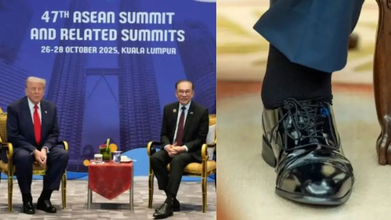- Health Conditions A-Z
- Health & Wellness
- Nutrition
- Fitness
- Health News
- Ayurveda
- Videos
- Medicine A-Z
- Parenting
- Web Stories
5 Breathing Exercises To Help You Calm Down During A Stressful Situation At Work

Breathing techniques to calm down during stressful situations (Credit: Canva)
It’s no surprise that stress has become a constant companion for many. From impending deadlines to never-ending meetings, the weight of responsibilities can feel overwhelming. Amidst the chaos, how often do we stop to breathe deeply and reset? Most people often forget the power of breathing and its profound effect on mental health and well-being.
Taking a few moments to practice mindful breathing can work wonders in bringing calmness and clarity to a busy workday. According to Saurabh Bothra, CEO & Certified Yoga Instructor, Habuild, “When was the last time you took a deep breath amidst the chaos of deadlines and demands? Sometimes, the weight of our responsibilities feels heavier than ever. The consistent stress can build up, and before we know it, health issues may start to take over.” This is why incorporating simple breathing exercises can help manage work-related stress effectively.
How Breathing Exercises Help in Stressful Situations?
Breathing exercises have been scientifically proven to help regulate the autonomic nervous system, reducing stress levels and lowering anxiety. Breathing deeply increases oxygen intake, which activates the parasympathetic nervous system, promoting relaxation.
Over time, regular practice of such techniques can reduce the intensity of the body’s stress response, making stressful situations more manageable.
Bothra adds, "Taking just a few moments to breathe—I'm talking about 5 to 10 minutes—can act as a refreshing midday boost! It’s a simple act, but it can calm your mind and help you regain focus."
Breathing techniques can offer immediate relief, providing a much-needed mental break that refocuses energy and attention. Here are five simple, yet powerful, breathing exercises that can be practiced during your workday to relieve stress and regain calm.
Here are five easy breathing exercises that can clear your head and help you get back to your day with more energy and less stress:
1. The 4-7-8 Technique
How to Practice: Sit comfortably and exhale fully through your mouth. Inhale deeply through your nose for a count of 4 seconds. Hold the breath for 7 seconds, and then exhale slowly through your mouth for 8 seconds. Repeat this process four times or until you feel a sense of calm.
This technique is a quick way to reset your mind and body. It’s especially useful in situations where you feel overwhelmed or anxious.
2. Box Breathing (Square Breathing)
How to Practice: Gently inhale through your nose for 4 seconds, hold the breath for another 4 seconds, exhale for 4 seconds, and hold for 4 seconds before repeating. Continue this cycle for several minutes or until you feel calm.
Box breathing is a simple, structured exercise that can reduce stress and increase focus. This technique is popular among high-performance professionals, such as athletes and Navy SEALs, for its effectiveness in promoting mental clarity.
This breathing technique not only helps in regulating emotions but also enhances concentration, making it a great tool to use before important meetings or presentations.
3. Bhramari Pranayama (Bee Breath)
How to Practice: Sit upright and perform the Shanmukhi Mudra by placing your little fingers below your mouth and your ring fingers above it. Put your thumbs over your ears. Inhale deeply through your nose, and as you exhale, make a gentle humming sound, like a bee. This technique helps slow the breath and encourages a state of relaxation.
Bhramari Pranayama, also known as "bee breath," uses humming to soothe the nervous system and is excellent for calming a racing mind.
The humming sound stimulates the parasympathetic nervous system, encouraging deep relaxation and alleviating stress.
4. The 3-Exhale Technique
How to Practice: Sit in a relaxed posture and slowly take a deep breath through your nose, completely filling your lungs. Then, breathe out through your mouth in three quick exhales. After exhaling, once again inhale deeply through the nose.
This breathing technique helps release tension quickly, especially if you’re feeling trapped in a situation where stress keeps building up. It’s a useful way to release pent-up stress energy.
This quick exhale sequence allows for a rapid release of tension, perfect for when you need a mental break but don’t have much time.
5. Equal Breaths
How to Practice: Slowly inhale through your nose for 5 seconds, then exhale through your mouth for another 5 seconds. Continue this pattern until you feel more relaxed and centered.
As the name suggests, this technique involves making the duration of your inhales and exhales equal. It’s a calming exercise that can be easily done while sitting at your desk or taking a brief break from work.
This breathing exercise helps stabilize your emotions and is particularly beneficial for staying calm under pressure, allowing you to respond to stressful situations with more control.
The power of breathing is often underestimated, especially when it comes to managing stress at work. However, a few minutes of focused breathing can make a significant difference in how you navigate your workday.
So, next time you find yourself caught up in the whirlwind of office stress, remember to pause, breathe, and reset. The benefits will not only be felt in the moment but will contribute to long-term mental health and resilience.
Long Walks Vs Several Short Walks? Study Reveals Which One Is Better For Your Health

(Credit-Canva)
Walking is said to be one of the best exercises. Not only is it an easy and accessible exercise, but it can be done anywhere and also does not need a lot of equipment. Many people aim for 10,000 steps a day as a sign of good health. But should you take one long walk, or multiple short ones? A new study has answered this question.
New research suggests that a single, longer walk each day is better for your heart than breaking up your steps into many short strolls, especially if you don't exercise regularly.
The study, published in Annals of Internal Medicine, found that walking for at least 15 minutes without stopping is ideal. This longer, steady pace, which is about 1,500 continuous steps gives your heart a much better workout.
Longer Vs Shorter Walks: Which is Better?
Researchers tracked the walking habits of over 33,500 adults in the UK who walked less than 8,000 steps a day. After tracking their health for eight years, the findings were clear:
Lower Heart Risk
People who consistently walked in longer, uninterrupted stretches had a lower risk of heart problems compared to those who only took short, quick bursts of steps.
Why Are Longer Walks Better For Health?
Even among the least active group (those walking under 5,000 steps daily), taking longer walks made a major difference. Their risk of heart disease and early death dropped significantly.
The researchers explain that most people focus only on the number of steps they take, but not the patterns. They suggests that even inactive people can boost heart health by changing their habits to walk for at least 10–15 minutes at a time.
Should People Focus More On How They Walk Or How Much?
Many people aim for 10,000 steps a day, but that number actually came from an old pedometer advertisement, not science. While experts agree more steps are generally good, this study emphasizes that how you walk matters more than just the total step count.
The researchers suggest that simple changes, like setting aside time specifically for a long walk, could make a big impact on heart health.
The NHS still recommends getting 150 minutes of moderate activity like brisk walking, each week, and ideally it should be spread out. For older adults, moving every day, even with light activity around the house, is key.
It's important to know that while the study shows a strong link between longer walks and better health, it doesn't definitively prove that walking directly causes the improvement.
However, health experts agree exercise is vital. They explain that you might find it hard at first, but it will get easier as your body adjusts. Even small improvements contribute to a healthy heart.
What Are Some Safety Tips for Walkers?
While walking is generally a safe activity, accidents can happen, especially if you like to walk alone. To stay safe while walking,
Be Visible
Wear bright, reflective clothing or carry a flashlight after dark or in dim light so drivers and others can easily spot you.
Stay Alert
Focus on your immediate surroundings; avoid distractions like your phone or headphones to always know what's happening around you, especially traffic.
Use Paths
Walk or bike only on marked paths, lanes, or sidewalks, and cross streets at designated crosswalks where vehicles are expecting pedestrians.
Donald Trump Health Update: First Hand Bruise, Now Swollen Ankle, Is The President Hiding A Health Crisis?

Credits: AFP/X
Donald Trump health has become a heated topic of debate and the concerns around his health has resurfaced after a photo from his Kuala Lumpur visit on Sunday, October 26, went viral. He was spotted with swollen ankles. The photo that went viral is from a meting of the Association of Southeast Asian Nations (ASEAN), which kicked off his six-day trip.
The pictures of his swollen ankle have flooded on social media and people are saying that his ankle is seen to be extremely swollen. As per experts, this happens due to chronic venous insufficiency, which is a condition Trump had earlier announced to be suffering from.

Chronic venous insufficiency occurs when the veins in the legs have trouble sending back to the heart. This causes blood to pool and creating high pressure. This is usually caused by damaged or weakened valves in the veins and is characterized by symptoms like leg swelling, aching, and heaviness, which improves with elevation. Risk factors include age, a history of deep vein thrombosis, and prolonged periods of sitting or standing.
However, Trump's latest physical test says something else. The White House physician Sean P Barbabella declared that the president "remains in exceptional health, exhibiting strong cardiovascular, pulmonary, neurological, and physical performance". Barbabella also stated that his "cardiac age was found to be approximately 14 years younger than his chronological age".
Trump's Legs Could Also Reveal That He Had A Stroke
As per a "Physical Therapist", who posts videos on Instagram by the username @epistemiccrisis with 74.2k followers, Trump also had his peroneal nerve paralyzed. He explains, "The deep branch of common peroneal nerve, which supplies a muscle known as the tibialis anterior, which blends your foot up toward your head when you walk. This is known as dorsiflexion. If this nerve is paralyzed, you would get a foot drop."
However, he notes that this can be easily remedied with a brace, called ankle foot orthosis or AFO. He said that the president was most likely wearing it as the outline of the posterior portion of "what looks like an AFO" could be seen through his pants.
Concerns On Trump's Health
Previously, the same "Physical Therapist" claimed that President Trump had a stroke. This is because he had difficulty walking in a straight line. In fact, a 2021 study published in journal Healthcare notes that stroke is a major cause of disability worldwide and balance impairments are common disabling factors in patients with stroke, which could lead to falls.
However, as per the official medical records of the president, no such strokes were mentioned. His medical report pronounced him in "excellent health". The examination was done at Walter Reed National Military Medical Center. The report also emphasized that Trump maintains a "demanding daily schedule without restriction". Not only that, the report has gone so far to declare Trump's cardiac age as 14 years younger than his actual age after an electrocardiogram.
This Simple Grip Test Could Predict Your Dementia Risk

Credits: Canva
Dr Peter Attia, physician, and researcher known for his work in longevity medicine believes that there is a correlation between your grip strength and dementia onset risk and dementia mortality.
Dr Attia says, "My best explanation for this is that grip strength is itself a proxy for overall strength. The type of strength we are talking about here is acquired, not inherited. You had to do a bunch of work to get it, and it is the work you did that is actually what's protect your brain."
He says that women who are over 40, must be able to hand on a bar for a minute and a half, and for men, it is two minutes. The key is that you are supposed to be able to carry 75% of your weight, he says, in an interview with CBS News' 60 minutes.
Is There Any Truth In The Claim That Grip Strength Has A Correlation With Dementia?
As per a 2021 study published in journal Frontiers in Aging Neuroscience, titled Grip Strength and the Risk of Cognitive Decline and Dementia: A Systematic Review and Meta-Analysis of Longitudinal Cohort Studies, loss of grip strength and cognitive impairment are prevalent in the elderly, and they may share the pathogenesis in common.
The study found that poorer grip strength was in fact associated with more risk of cognitive decline and dementia. The subgroup analysis within the study also indicated that people with poorer strength had more risk of Alzheimer's disease and non-AD dementia.
But why does this happen? Lower grip strength is a marker for overall muscle mass, general health, and is linked to the health of the brain and its blood vessels. This link is also connected to other factors like vascular health, cognitive decline, and physical activity, as low grip strength can be a symptom of poor overall physical and metabolic health.
How Is Lower Grip Strength Is Linked To Dementia?
Indicator Of Overall Health: Grip strength reflects the health of entire body, this is why a lower grip strength is an indicate of lower muscle mass, and general poor health.
Vascular and brain health: Since there is a connection between muscle strength, blood flow, and brain health, thus lower grip strength is associated with a higher risk of vascular dementia and a greater volume of white matter hyperintensities in the brain.
Also Read: What Home Gym Tools Can Help You Stay Fit Without Hitting The Gym?
Poorer grip strength is associated with lower cognitive function, such as fluid intelligence and prospective memory. This suggest a link between the body's physical capabilities and the brain's cognitive abilities.
A different study published in 2022, where 40,000 participants from the UK Biobank were studied found that greater grip strength was associated with better cognitive functioning, higher life satisfaction, greater subjective well-being, and reduced depression and anxiety symptoms while controlling for numerous demographic, anthropometric, and socioeconomic cofounders.
The study also found that grey matter volume of subcortical region also correlated with better mental health and considerably mediated their relationship with grip strength.
© 2024 Bennett, Coleman & Company Limited

